SEO keywords are the backbone of every search engine optimization strategy. They determine how easily your audience can find your website when searching for products, services, or information online. Without the right keywords, even the best content can get lost in search results. In this blog, we’ll explain what SEO keywords are, why they matter, and how professional SEO services, like those from The Maddex, can help your business rank higher and grow faster.
What Are SEO Keywords?
SEO keywords are the specific words, phrases, or questions that people type into search engines like Google, Bing, or Yahoo when they’re looking for answers, products, or services. These keywords tell search engines what a webpage is about and help them decide whether your content is relevant enough to show in search results.
Think of SEO keywords as a bridge connecting your business to potential customers: on one side, you have your website and the solutions you provide; on the other side, there are people searching for exactly what you offer. The right keywords help search engines understand this connection and display your site to the right audience.
For example, if someone searches for “affordable SEO services for small businesses”, Google will show results that closely match that phrase. If your page is optimized for similar keywords like “budget SEO for startups” or “low-cost small business SEO packages,” your website is more likely to appear, even if the wording isn’t identical.
By targeting the right keywords, you ensure your website is:
- Visible to the right audience: You reach users already interested in your products or services.
- Relevant in search results: Search engines know your content matches user intent.
- More likely to convert: Visitors searching with specific keywords are usually closer to making a decision or purchase.
In short, SEO keywords are the foundation of search engine optimization; without them, your content won’t rank, and your target audience won’t find you.
How to Find Your Best SEO Keywords
Choosing the best keywords isn’t about guessing; it’s about understanding your audience and researching what they actually search for. Once you understand your audience and their search intent, the next step is to use keyword research tools to uncover high-potential keywords. These tools not only show you what people are searching for but also provide insights like search volume, competition level, and related keyword ideas. Here are some of the best tools you can use:
1. Google Keyword Planner (Free)
Google’s own keyword tool is a staple for beginners and professionals alike. It shows monthly search volume, competition levels, and keyword suggestions straight from Google’s database. You can also filter results by location, which is especially useful for local SEO campaigns.
Best for: Beginners and advertisers using Google Ads.
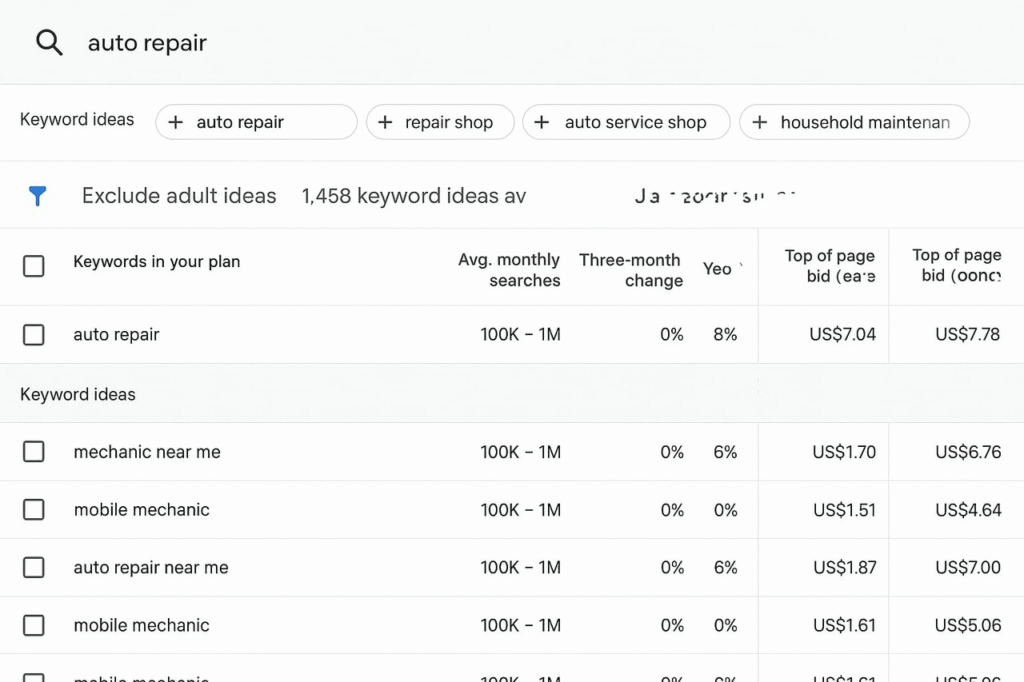
Google Keyword Planner: “Auto Repair” Keyword Analysis
- Search Volume: “Auto repair” gets 100K – 1M monthly searches in the U.S., indicating strong demand. Related terms like “mechanic near me” and “mobile mechanic near me” show similar volume.
- Trends & Change: Three-month and year-over-year changes are mostly 0%, except “mechanic near me” (–90% YoY).
- Competition: “Auto repair” has Low competition; others like “mobile mechanic near me” show Medium.
- Ad Cost (CPC): Top of page bid ranges from $1.51 to $7.78, showing moderate to high advertiser interest.
- Takeaway: Broad keywords like “auto repair” offer reach, while local variations bring more qualified leads with lower competition.
2. SEMrush
SEMrush is an all-in-one SEO platform that provides detailed keyword metrics, competitor keyword analysis, and topic clustering. It’s particularly useful for finding keyword gaps, terms your competitors rank for but you don’t, allowing you to capture missed opportunities.
Best for: Businesses looking for advanced data and competitive insights.
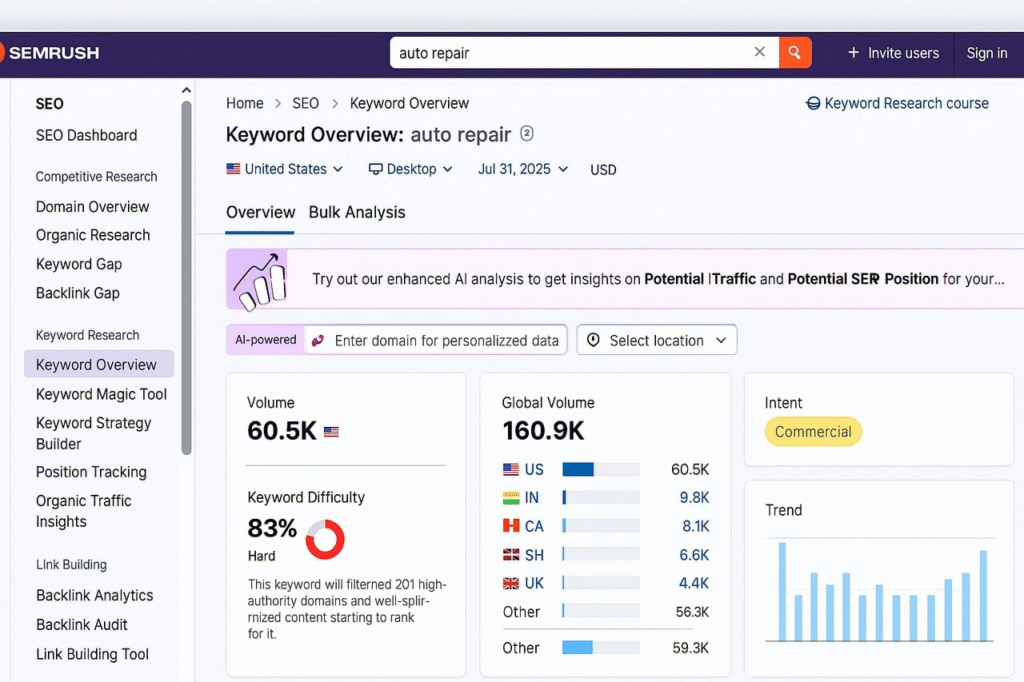
Example: Using SEMrush to Analyze “Auto Repair” Keywords
The screenshot above shows how SEMrush provides an in-depth overview of the keyword “auto repair.” It displays:
- Search Volume: 60.5K monthly searches in the U.S., with a global volume of 160.9K, showing strong demand for this keyword worldwide.
- Keyword Difficulty: 83% (hard), meaning ranking for this keyword requires high-quality content and strong backlinks.
- Search Intent: Marked as Commercial, indicating users are likely looking for services, making it ideal for businesses targeting conversions.
- Trend Analysis: A monthly breakdown showing how interest fluctuates over time, helping you plan seasonal campaigns.
By using insights like these, you can decide whether to target broad keywords like “auto repair” or focus on long-tail variations (e.g., “auto repair shop near Houston Medical Center”) to capture more qualified traffic with less competition.
3. Ahrefs
Ahrefs is one of the most powerful tools for SEO professionals. Its Keyword Explorer gives you keyword difficulty scores, search volume, click data, and SERP analysis so you can see who’s ranking and why. It’s excellent for identifying long-tail keywords with realistic ranking potential.
Best for: Detailed keyword and backlink analysis for growth-focused SEO.
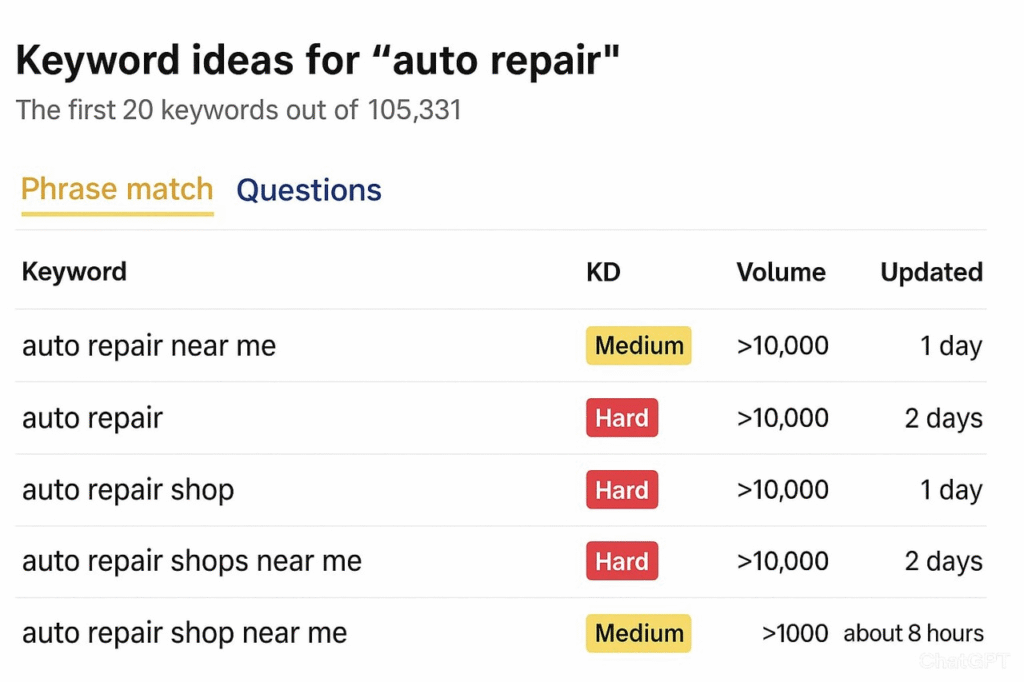
Example: Using Ahrefs to Find Keyword Ideas for “Auto Repair”
The screenshot above shows keyword suggestions for “auto repair” using Ahrefs. It provides detailed insights for each keyword variation, including:
- Keyword Difficulty (KD): Shows how hard it is to rank for each keyword. For example, “auto repair” and “auto repair shop” are marked Hard, meaning they require strong backlinks and high-quality content to rank. Meanwhile, “auto repair near me” has Medium difficulty, making it a more achievable target.
- Search Volume: Displays the average monthly searches (e.g., “auto repair near me” exceeds 10,000 searches per month). This helps prioritize high-demand keywords.
- Freshness of Data: Updated as recently as a few hours or days ago, giving you real-time keyword insights for current trends.
By analyzing these metrics, businesses can decide whether to target high-volume, competitive keywords or focus on medium-difficulty long-tail keywords like “auto repair shop near me” for quicker rankings and local search visibility.
4. Ubersuggest
Created by Neil Patel, Ubersuggest is an affordable alternative to premium tools. It provides search volume, SEO difficulty, and content ideas based on your keywords. It’s beginner-friendly and ideal for small businesses testing keyword strategies.
Best for: Budget-friendly keyword research with quick insights.
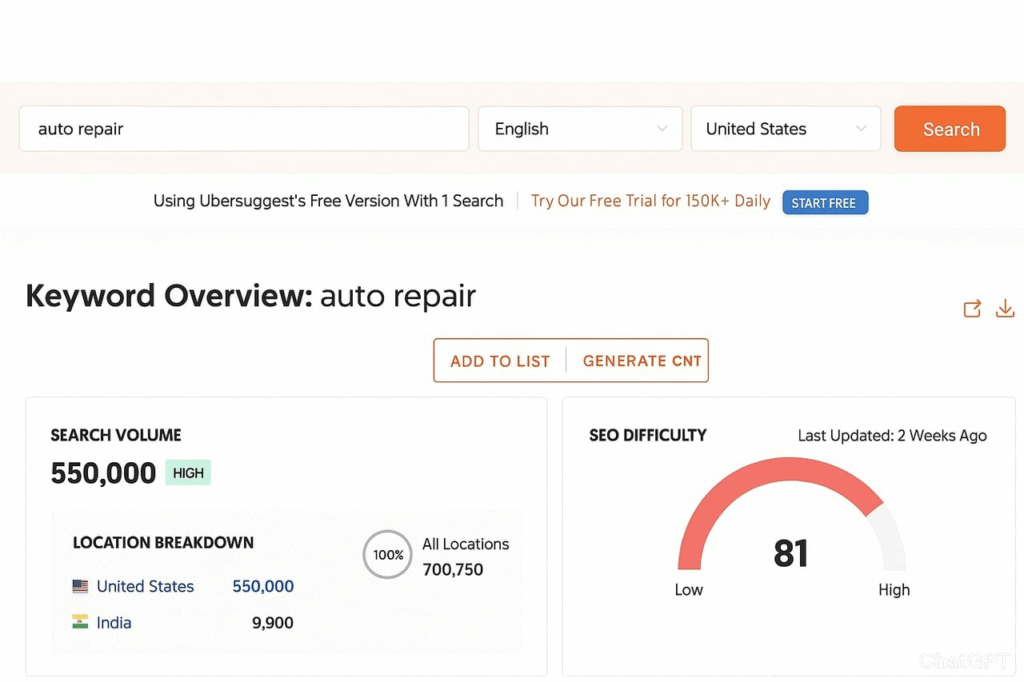
Example: Using Ubersuggest to Analyze “Auto Repair” Keywords
The screenshot above demonstrates how Ubersuggest provides keyword insights for “auto repair.” It includes:
- Search Volume: Shows a very high search volume of 550,000 searches per month in the U.S., making it a valuable but competitive keyword to target.
- Location Breakdown: Highlights where most searches come from, in this case, 78% from the United States, and smaller volumes from countries like India. This helps businesses focus their keyword strategy on the right geographic markets.
- SEO Difficulty Score: Displays a difficulty rating of 81 (High), meaning ranking for this keyword will require strong SEO strategies, including authoritative backlinks and optimized content.
- Data Freshness: Recently updated within the last two weeks, ensuring the keyword insights reflect current search trends.
With this data, you can decide whether to compete for the broad keyword “auto repair” or optimize for long-tail variations (like “auto repair shop near me”) for faster, localized results.
5. AnswerThePublic
This tool visualizes questions, prepositions, and comparisons people search for around a keyword. It’s perfect for content ideation, helping you understand the exact questions your audience asks so you can create blogs, FAQs, or videos that directly answer them.
Best for: Generating blog topics and addressing audience questions.
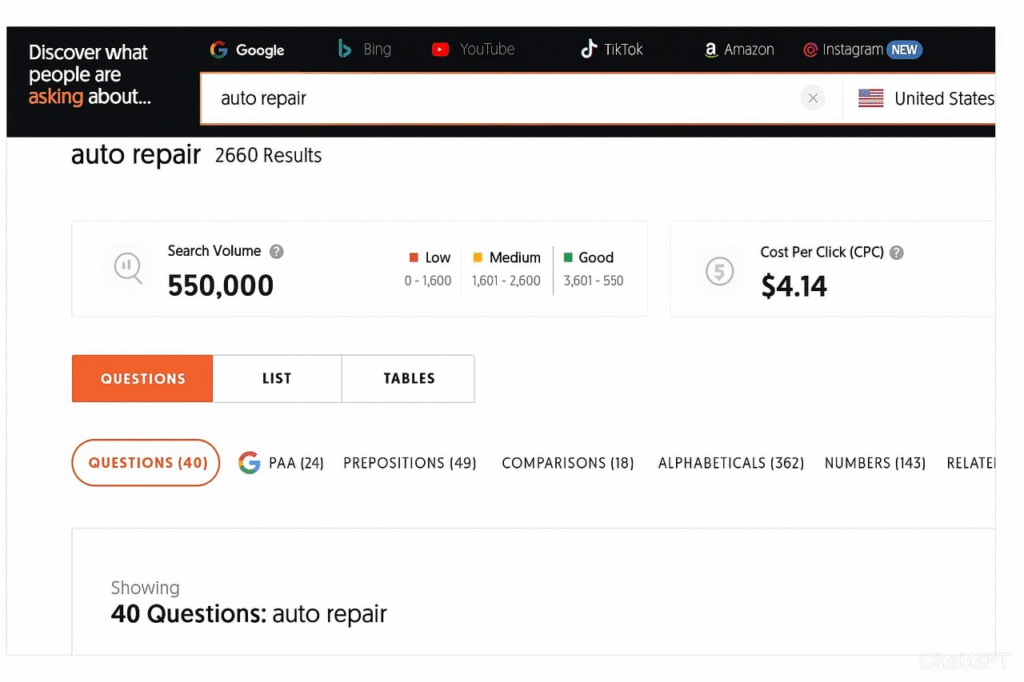
Example: Using Answer The Public to Analyze “Auto Repair” Keywords
The screenshot above demonstrates how Answer The Public generates content and keyword insights for the term “auto repair.” It includes:
- Search Volume: Shows an extremely high monthly search volume of 550,000 in the United States, indicating that “auto repair” is a highly searched and competitive topic. This makes it an excellent keyword to target for blogs, landing pages, and service-based content.
- Cost Per Click (CPC): The CPC is $4.14, suggesting strong commercial intent. Marketers and businesses can leverage this by creating content that not only ranks but also converts, since advertisers are paying a premium to target this keyword.
- Content Opportunities (Question-Based Results): Answer The Public displays 40 popular user questions related to “auto repair.”
These real user questions help content creators tailor their blogs, FAQs, and service pages to what people are actively searching for.
How to Make SEO Keywords Boost Your Rankings
Finding the right keywords is only half the battle; the real impact comes from how you use them. Search engines like Google look at the placement, relevance, and natural usage of keywords to determine whether your content deserves to rank high. Here’s how to maximize their power:
1. Place Keywords in Key Spots
Strategic placement ensures search engines understand your page’s topic immediately. Include your primary keyword in:
- The title tag (H1) and main heading of the page
- At least one H2 or H3 subheading
- The meta description (to improve click-through rate)
- The first 100 words of your content (to set context early)
- Image alt text and file names (for image SEO)
Example: If your keyword is “affordable SEO services,” your H1 could be “Affordable SEO Services for Small Businesses That Deliver Results.”
2. Write for Humans First
Search engines reward helpful, user-focused content. Keyword stuffing, repeating the same phrase unnaturally, can harm rankings and turn readers away. Instead:
- Use keywords naturally within sentences
- Answer user questions thoroughly and clearly
- Prioritize readability over keyword density
Tip: If the sentence feels awkward when read aloud, rephrase it while keeping the meaning intact.
3. Support With Related Keywords
Modern search algorithms use semantic search (LSI keywords) to understand topics beyond exact phrases. Add related terms, synonyms, and variations to create comprehensive content. For example, if targeting “SEO keywords,” include related terms like “keyword research,” “search intent,” and “keyword ranking factors.”
This approach improves your chances of ranking for multiple related queries and signals topical authority.
4. Keep Content Updated
Search trends evolve; what’s relevant today may not be tomorrow. Regularly revisit your pages to:
- Refresh outdated statistics or examples
- Add emerging keywords that have gained popularity
- Update headings and meta tags with current search intent
Keeping content updated tells search engines your page is fresh and relevant, improving its chances to rank higher.
Why This Strategy Works
By combining proper placement, natural writing, related terms, and ongoing updates, you create content that appeals to both users and search engines. This dual focus boosts rankings, increases click-through rates, and ultimately drives more qualified traffic to your site.
Want to Rank Higher? Let The Maddex Handle It
Keyword research is just the first step; turning it into real traffic and revenue takes expertise. At The Maddex, we create tailored SEO strategies that include smart keyword targeting, on-page and technical optimization, and content that actually converts. Whether you’re a startup or an established brand, we’ll help you climb search rankings and stay there.
Ready to grow? Contact The Maddex today and get your custom SEO plan.



